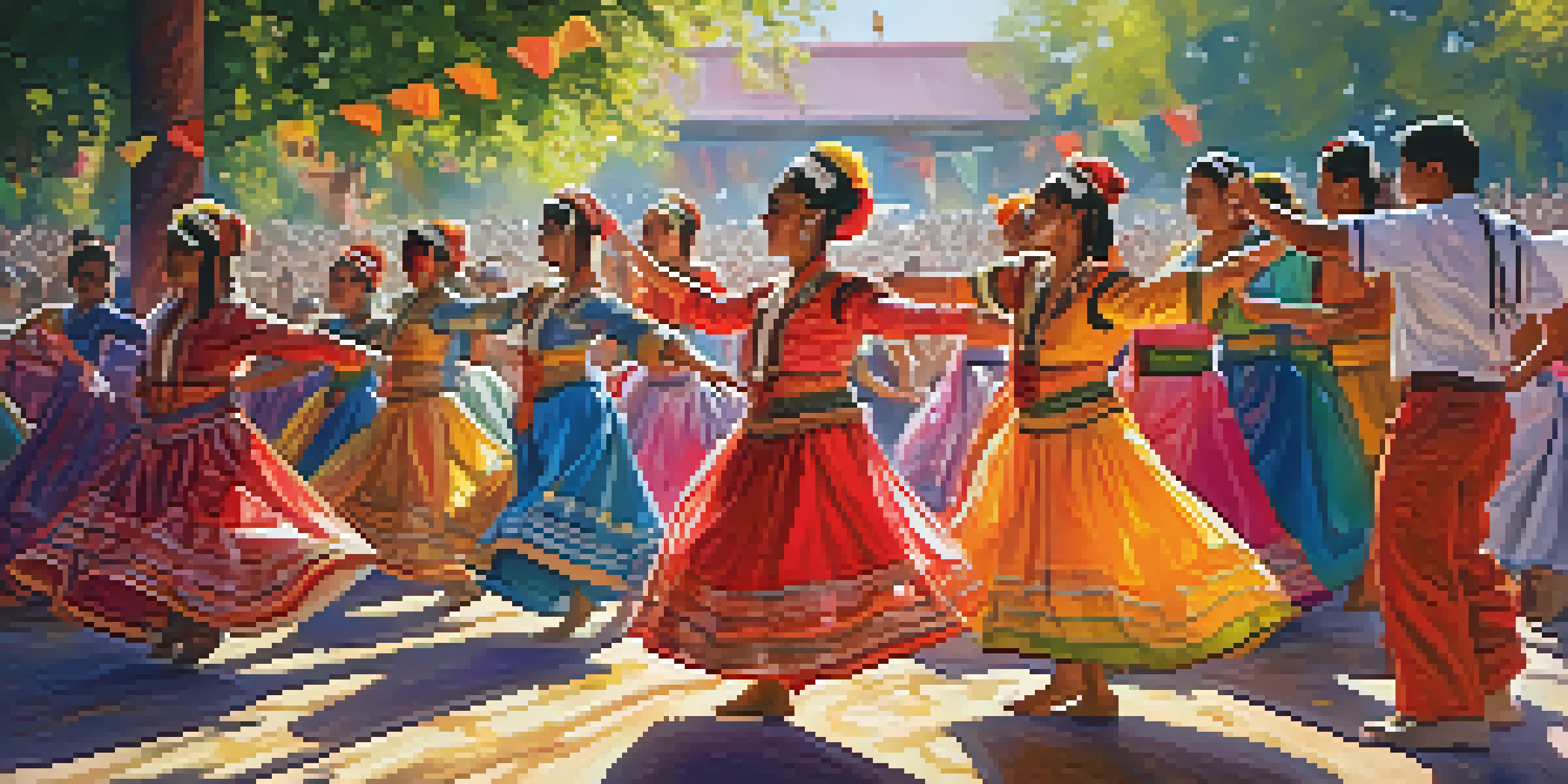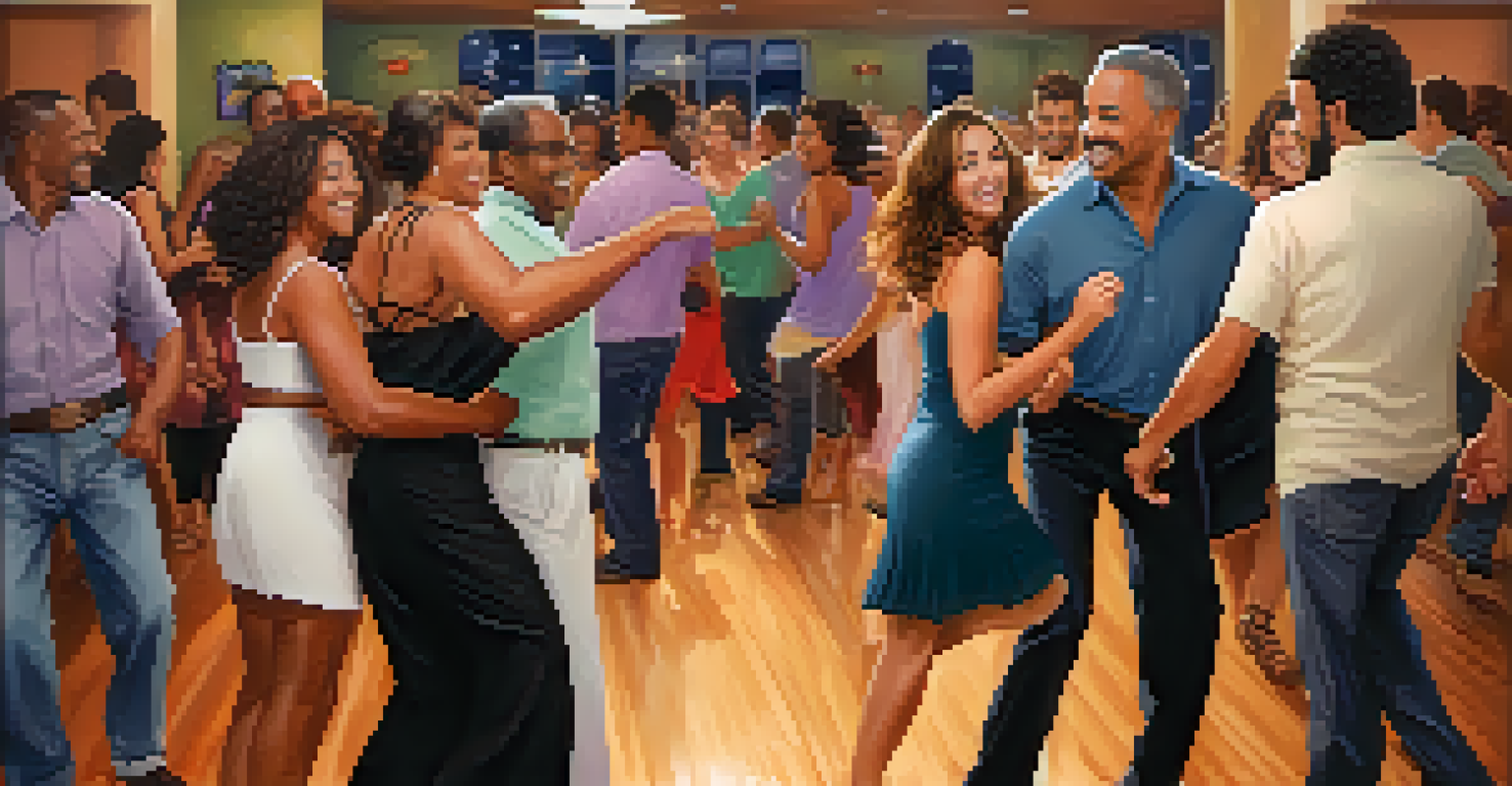The Role of Dance in Facilitating Cross-Cultural Understanding

Dance as a Universal Language Across Cultures
Dance has an incredible ability to transcend language barriers. No matter where you are in the world, the rhythm and movement of dance can convey emotions and stories without a single word. Just like a smile can be understood by anyone, a dance can communicate feelings of joy, sorrow, celebration, or longing.
Dance is the hidden language of the soul.
For instance, a traditional African dance may express community and unity, while a classical ballet performance might illustrate themes of love and loss. These different forms of expression allow people to connect with emotions that are universally human. Thus, dance serves as a bridge, linking diverse cultures through shared feelings.
When people come together to dance, they often find common ground, fostering mutual respect and understanding. This shared experience can lead to deeper conversations and connections, paving the way for cross-cultural relationships that might not have formed otherwise.
Cultural Exchange Through Dance Festivals
Dance festivals around the world are vibrant celebrations that showcase various cultural traditions. Events like the Edinburgh Festival Fringe or the International Festival of Dance in Sydney bring together dancers from different backgrounds, creating a melting pot of styles and ideas. Here, attendees can experience the richness of global dance forms in one place.

These festivals not only entertain but also educate. Workshops and performances provide opportunities for participants to learn about the history and significance of different dance styles. This exposure cultivates appreciation and respect for cultural differences, encouraging individuals to engage with traditions outside their own.
Dance Connects Cultures Globally
Dance serves as a universal language, transcending barriers and fostering emotional connections across diverse cultures.
Moreover, when dancers collaborate across cultures, they create unique fusions that highlight the beauty of diversity. Such collaborations can lead to innovative performances that reflect a blend of techniques and storytelling methods, promoting a greater understanding of the cultures involved.
Dance Education as a Tool for Cultural Awareness
Incorporating dance into educational curricula is an effective way to promote cultural awareness among students. By learning about different dance forms, students gain insights into the history and values of various cultures. This hands-on approach makes the learning experience more engaging and memorable.
The dance is a poem of which each movement is a word.
For example, a classroom that explores Bollywood dance can also delve into the significance of storytelling in Indian culture. This kind of immersive learning helps students appreciate the context behind the movements, encouraging them to see dance as more than just steps but as a reflection of societal values and beliefs.
As students participate in these dance lessons, they also develop empathy and a sense of global citizenship. They learn to appreciate the uniqueness of other cultures while recognizing the shared humanity that dance embodies, fostering a more inclusive worldview.
Social Dance as a Medium for Building Community
Social dance forms, like salsa or swing, create spaces for people to come together and connect. These dances encourage interaction and collaboration, breaking down social barriers that often exist in our daily lives. When people engage in social dancing, they form bonds that can lead to friendships and community building.
For instance, a local salsa night at a community center can attract individuals from various backgrounds. As they learn to dance together, they share laughter, mistakes, and triumphs, creating a sense of camaraderie. This shared experience can foster a deeper understanding of each other's cultures in a relaxed and enjoyable setting.
Festivals Enhance Cultural Exchange
Dance festivals provide vibrant platforms for showcasing cultural traditions, promoting education, and encouraging collaboration among artists.
Social dancing also promotes inclusivity and acceptance. In these spaces, participants often find that they can express themselves freely, allowing for a rich exchange of cultural practices and ideas. This dynamic not only strengthens community ties but also builds bridges across diverse cultures.
Dance as a Tool for Activism and Social Change
Throughout history, dance has served as a powerful form of activism. From protest dances to flash mobs, movement has been used to raise awareness and inspire change on social issues. These performances can highlight injustices and bring people together to advocate for a common cause.
For instance, the 'Dancing for Change' movement uses dance performances to address issues like climate change and social inequality. By using the art of dance, activists can convey messages in a compelling and relatable way, reaching audiences who might not engage with traditional forms of activism.
Moreover, dance as activism often invites participation from diverse groups, encouraging collective action. It offers a platform for voices that might otherwise go unheard, fostering a sense of solidarity and shared purpose across cultural divides.
Healing and Therapeutic Benefits of Dance in Diverse Settings
Dance therapy has emerged as a vital tool for healing across cultures. By engaging in movement, individuals can express emotions that might be difficult to articulate verbally. This approach is especially beneficial in multicultural settings where language differences can hinder communication.
For example, refugee communities often use dance as a form of therapy to process trauma and build resilience. Through shared movement, participants can connect with one another, creating a supportive environment that fosters healing and understanding. This communal experience can help alleviate feelings of isolation and promote a sense of belonging.
Dance Fosters Community and Healing
Social dance creates inclusive spaces for community building, while dance therapy aids in emotional healing and understanding among diverse groups.
Additionally, dance therapy can help bridge cultural gaps by incorporating diverse dance styles. By valuing each participant’s cultural background, therapists can create a holistic approach to healing that honors individual experiences while promoting unity.
The Future of Dance in Global Cultural Understanding
As globalization continues to intertwine cultures, dance will play an increasingly crucial role in fostering understanding. With the rise of digital platforms, people can now share their dance forms with a global audience, creating new opportunities for cultural exchange. This accessibility allows for greater appreciation and respect for diverse traditions.
Moreover, collaborations between artists from different cultures are likely to increase, leading to innovative dance projects that celebrate diversity. These partnerships can inspire future generations to embrace multiculturalism and view dance as a means of connection rather than division.

As we look ahead, it's essential to nurture this cultural dialogue through dance. By supporting local dance initiatives and engaging in cross-cultural experiences, we can continue to build a world where understanding and appreciation for diversity thrive, making dance a powerful catalyst for change.